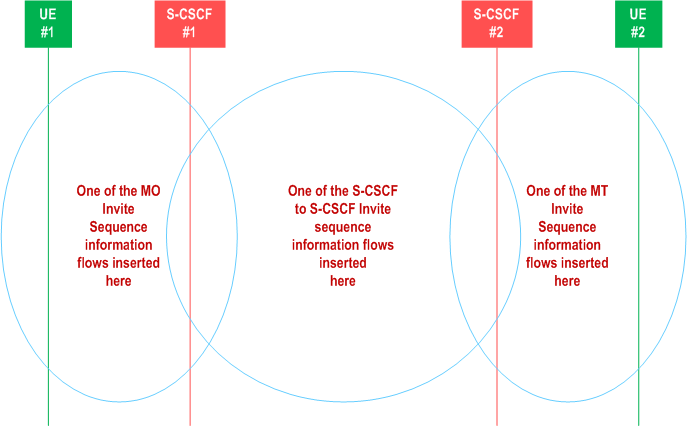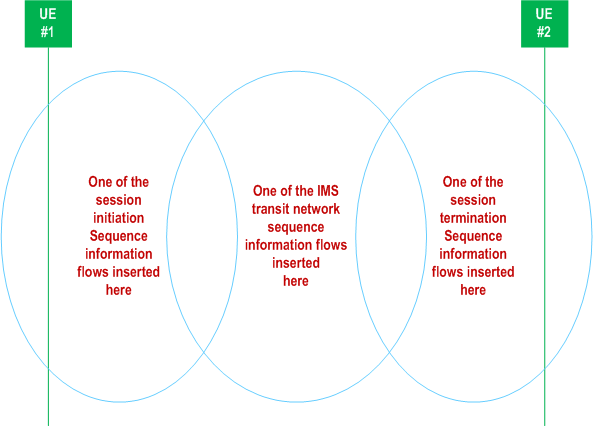Content for TS 23.228 Word version: 19.1.0
1…
3…
4…
4.2.4…
4.3…
4.4…
4.13…
4.16…
5…
5.2…
5.3…
5.4…
5.4.7…
5.4.8…
5.4a…
5.5…
5.5.3…
5.6…
5.6.3…
5.7…
5.7.3…
5.7.5…
5.7.8…
5.8…
5.10…
5.11…
5.11.3…
5.11.3.3
5.11.3.4
5.11.4…
5.11.5…
5.11.5.3…
5.11.6…
5.12…
5.16…
5.16.2…
5.19…
5.20…
A…
E…
E.2.2…
G…
G.5…
H
I…
J…
K…
L…
M…
M.3…
N…
P…
Q…
Q.2.5…
R…
S…
T…
U…
U.2…
V…
W…
X…
Y…
Z…
AA…
AA.3…
AB…
AC…
AC.7…
AC.7.2…
AC.7.2.2
AC.7.2.3…
AC.7.4…
AC.7.9…
AC.7.9.3…
AC.7.10…
AC.7.10.4.2…
AC.9…
AC.10…
AC.11…
AD…
AE…
AF…
AG…
5.4a Overview of session flow procedures
5.4a.1 End-to-End session flow procedures
5.4a.2 Transit network session flow procedures
...
...
5.4a Overview of session flow procedures |R6| p. 107
5.4a.1 End-to-End session flow procedures |R7| p. 107
This clause contains the overview description and list of individual procedures for the end-to-end session flows.
For an IP Multi-Media Subsystem session, the session flow procedures are shown in the following diagram.

The following procedures are defined:
For the origination sequences:
- (MO#1) Mobile origination, roaming , see clause 5.6.1;
- (MO#2) Mobile origination, home, see clause 5.6.2;
- (PSTN-O) PSTN origination, see clause 5.6.3;
- (NI-O) Non-IMS network origination (external SIP client), see clause 5.6.4;
- (AS-O) Application Server origination, see clause 5.6.5.
- (MT#1) Mobile termination, roaming, see clause 5.7.1;
- (MT#2) Mobile termination, home, see clause 5.7.2;
- (MT#3) Mobile termination, CS Domain roaming, see clause 5.7.2a;
- (PSTN-T) PSTN termination, see clause 5.7.3;
- (NI-T) Non-IMS network termination (external SIP client), see clause 5.7.4;
- (AS-T#1) PSI based Application Server termination, direct, see clause 5.7.5;
- (AS-T#2) PSI based Application Server termination, indirect, see clause 5.7.6;
- (AS-T#3) PSI based Application Server termination, direct, using DNS, see clause 5.7.7;
- (AS-T#4) PUI based Application Server termination, indirect, see clause 5.7.8.
- (S-S#1) Session origination and termination are served by different network operators, see clause 5.5.1;
- (S-S#2) Session origination and termination are served by the same operator, see clause 5.5.2;
- (S-S#3) Session origination with PSTN termination in the same network as the S-CSCF, see clause 5.5.3;
- (S-S#4) Session origination with PSTN termination in a different network to the S-CSCF, see clause 5.5.4.
- (MO#2) Mobile origination, home,
- (S-S#2) Single network operator,
- (MT#2) Mobile termination, home.
| Origination Procedure (pick one) |
Serving-CSCF-to- Serving-CSCF Procedure (pick one) |
Termination Procedure (pick one) |
|---|---|---|
|
MO#1
Mobile origination, roaming, home control of services (2).
MO#2
Mobile origination, located in home service area.
PSTN-O
PSTN origination.
AS-O
Application Server origination
NI-O
Non-IMS network origination
|
S-S#1
Different network operators performing origination and termination, with home control of termination (2).
|
MT#1
Mobile termination, roaming, home control of services(2).
MT#2
Mobile termination, located in home service area.
MT#3
Mobile termination, CS Domain roaming.
AS-T#1,2,3,4
Application Server terminations
NI-T
Non-IMS network termination
|
|
MO#1
Mobile origination, roaming, home control of services (2).
MO#2
Mobile origination, located in home service area.
AS-O
Application Server origination
|
S-S#2
Single network operator performing origination and termination, with home control of termination.
|
MT#1
Mobile termination, roaming, home control of services(2).
MT#2
Mobile termination, located in home service area.
MT#3
Mobile termination, CS Domain roaming.
AS-T#1,2,3,4
Application Server terminations
|
|
MO#1
Mobile origination, roaming, home control of services (2).
MO#2
Mobile origination, located in home service area.
AS-O
Application Server origination
|
S-S#3
PSTN termination in the same network as the S-CSCF.
|
PSTN-T
PSTN termination.
|
|
MO#1
Mobile origination, roaming, home control of services (2).
MO#2
Mobile origination, located in home service area.
AS-O
Application Server origination
|
S-S#4
PSTN termination indifferent network than the S-CSCF
|
PSTN-T
PSTN termination.
|
5.4a.2 Transit network session flow procedures |R7| p. 110
In addition to the combinations of flows constructed from the above scenarios, elements of an IMS network may be used by an operator in support of transit network scenarios. Figure 5.9a shows session flow combinations for transit network scenarios.

| Origination Procedure (pick one) | IMS Transit Network Procedure | Termination Procedure (pick one) |
|---|---|---|
|
MO#1
Mobile origination, roaming, home control of services (2).
MO#2
Mobile origination, located in home service area.
PSTN-O
PSTN origination.
NI-O
Non-IMS network origination
|
I-T
IMS Transit Network
|
MT#1
Mobile termination, roaming, home control of services(2).
MT#2
Mobile termination, located in home service area.
MT#3
Mobile termination, CS Domain roaming.
PSTN-T
PSTN termination.
NI-T
Non-IMS network termination
|
The following procedures are defined:
For the origination sequences:
- (MO#1) Mobile origination, roaming , see clause 5.6.1;
- (MO#2) Mobile origination, home, see clause 5.6.2;
- (PSTN-O) PSTN origination, see clause 5.6.3;
- (NI-O) Non-IMS network origination (external SIP client), see clause 5.6.4;
- (MT#1) Mobile termination, roaming, see clause 5.7.1;
- (MT#2) Mobile termination, home, see clause 5.7.2;
- (MT#3) Mobile termination, CS Domain roaming, see clause 5.7.2a;
- (PSTN-T) PSTN termination, see clause 5.7.3;
- (NI-T) Non-IMS network termination (external SIP client), see clause 5.7.4;